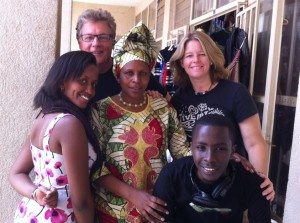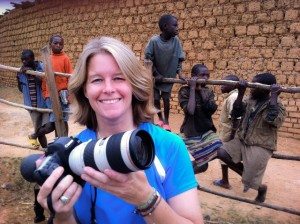 What do you get when you put two terrific storytellers in charge of a PR shoot? A great story, that’s what, and some useful lessons on how to capture stunning video with compact, light-weight equipment.
What do you get when you put two terrific storytellers in charge of a PR shoot? A great story, that’s what, and some useful lessons on how to capture stunning video with compact, light-weight equipment.
“The Sewing Machine” is a video produced by former NBC reporter John Larson and one-time NPPA photojournalist of the year Lisa Berglund. It’s a video with a clear purpose–to raise money for VisionFund, the microfinance arm of World Vision International. But it’s also a story that illustrates many fundamental principles of good storytelling.
First, a strong central character. As with many PR shoots, an advance team had done the legwork at a remote location in Rwanda. But Larson and Berglund, being newsies, didn’t think much of the original plan, as Larson explained in the Facebook Storytellers group:
We rejected story lines that had been set up for a month, and found the sewing machine woman because we were searching for a more photo-rich, metaphorical story line. We found and selected the stronger details and story lines within her story.
Second, the story has a clear beginning, middle and end. In this case, there’s a story within the story, which has its own beginning, middle and end. But the viewer never feels lost or confused. See what you think when you watch the video.
Because this wasn’t a news story, Berglund and Larson did a ton of set-up. To use a news term, they staged the shoot, moving locations to get a more photogenic background, deciding what people should wear, and matching shots they knew they would re-create when they got back to the United States.
 And because this wasn’t a news story, Berglund had the courage to shoot it with a camera she had never used before–the Canon 5D–a digital SLR. “It is not good in reactive situations (like news),” Larson says. “The lenses are slow, bulky, time consuming… and gorgeous.” Virtually everything was shot with natural light.
And because this wasn’t a news story, Berglund had the courage to shoot it with a camera she had never used before–the Canon 5D–a digital SLR. “It is not good in reactive situations (like news),” Larson says. “The lenses are slow, bulky, time consuming… and gorgeous.” Virtually everything was shot with natural light.
Audio was a different matter, Berglund says.
Monitoring audio is one of the biggest challenges. Most of the audio was shot with my Sennheiser MKH-60, plugged into a Zoom H4N audio recorder. The interviews were shot with a Lectrosonic 400 series wireless, also plugged into the Zoom.
Because so much additional equipment was required, Berglund wound up recruiting an assistant on the spot who carried the recorder, wore headphones and got the mics in close.
Sound is my passion. It was really hard to give up complete control. But the risk was worth it in the end, and allowed me to concentrate on the visuals.
One of the most memorable moments in the video is the shot that reveals how the woman expanded her business. It’s a lock-down shot that was carefully planned, with each individual element shot separately and then combined in the edit room. “The trick is using the effect when the narrative is building, or adding, or growing,” says Larson. “Then the effect supports the story you’re trying to tell.” So it does.









2 Comments
[…] both Larson and Berglund. Lisa talks about the camera with which she shot this breathtaking video. https://www.newslab.org/2011/11/23/once-a-storyteller-always-a-storyteller/ LD_AddCustomAttr("AdOpt", "1"); LD_AddCustomAttr("Origin", "other"); […]
[…] Larson says, “I began micro lending 5 years ago as an anti-depressant. I was a journalist in Los Angeles, mostly covering the latest self-inflicted wounds of Hollywood celebrities like Paris Hilton, Lindsay Lohan and Mel Gibson. I began loaning money through Kiva in an effort to stay sane. Eventually, I did several stories about Kiva.” http://video.cnbc.com/gallery/?video=604752752). In 2010, when Vision Fund (World Vision) asked for a proposal to tell its story, I jumped at the opportunity. https://www.newslab.org/2011/11/23/once-a-storyteller-always-a-storyteller/ […]